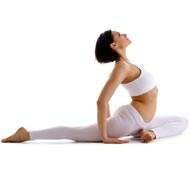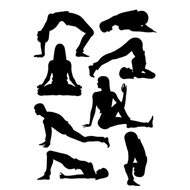One Legged King Pigeon Pose - Eka Pada Rajakapotasana
Eka Pada Rajakapotasana or One-Legged King Pigeon Pose is an asana that is performed in the seated position. It is a backbend that causes the chest to puff up, therefore making the practitioner resemble a pigeon.
The meaning of 'Eka'; in Sanskrit is one, 'pada'; is leg or foot, and 'raja'; is king. The meaning of 'kapota'; is dove or pigeon.
Although this pose is easy to perform, it comes under the advanced poses. Another effective backbend you could try is Camatkarasana (Wild Thing Yoga Pose).
Steps :
- To begin this pose, you should first come to Adho Mukha Shvanasana (Downward Facing Dog). Then, bring your right knee forward so that it rests behind your right wrist.
- Next, bend your right knee and flatten it on the ground, such that your knee touches your right hand, and your toes touch your left hand. At the same time bring your left leg down on the ground.
- Let your lower back lengthen by bringing your tailbone forward and down so that your pubis is pulled toward your navel. The left side of your hip should come towards your right heel so that the left groin is stretched.
- Bend your left knee and with your left hand and reach for your left foot.
- Bring your head back till the sole of your feet touches the top of your head or is close to it. Remain in this position for a minute.
Precautions :
- Avoid this pose if you are suffering from sacroiliac injury, ankle injury, knee injury, and tight thighs or hips.
- This backbend is quite an intense backbend and only experienced practitioners should attempt it.
Beginner's Tip :
During the initial stages, students are not able to hold onto the foot directly with their hands. To counter this problem, a good beginner';s tip forthis Pose is that you could make use of a strap to hold your foot.
It can also be difficult at times to bring the outer part of the front-leg hip to the ground. To solve this problem you could use a blanket that is thickly folded under the hip to give support. You could also ask another person to help you lift your arms.
Benefit To Body Part
- It helps in stretching the neck, shoulders, chest, abdomen, groin, and thighs.
- It helps in stimulating the organs of the abdomen.
- It is effective in opening the chest and shoulders.
Therapeutic Applications :
- Regular practice of this pose is said to effective in the treatment and management of urinary disorders.
- Since the pose provides a deep internal massage of the abdominal organs, it helps in improving digestion and vitalizing the immune system.
Variations :
- One of the more restorative variations for One-Legged King Pigeon Pose is to let your torso bend over your front shin. Bring your arms to stretch forward along the yoga mat. Let your forehead rest by keeping it on a yoga block, folded blanket, or on your hands. Your front leg should bear the weight of your body.
- Another variation is to bring the front leg to extend out, like in a split. This variation may be more difficult for those who are not as flexible and are unable to a regular split.
Preparatory Poses :
- Cobbler Pose (Baddha Konasana)
- Cobra Pose (Bhujangasana)
- Cow Face Pose (Gomukhasana)
- Bridge Pose (Setu Bandha Sarvangasana)
- Reclining Bound Angle Pose (Supta Baddha Konasana)
- Extended Triangle Pose (Utthita Trikonasana)
- Reclined Hero Pose (Supta Virasana)
Follow Up Poses :
- Child's Pose (Balasana)
- Noose Pose (Pasasana)
- Downward Facing Dog Pose (Adho Mukha Svanasana)
- Bharadvaja's Twist (Bharadvajasana I)



